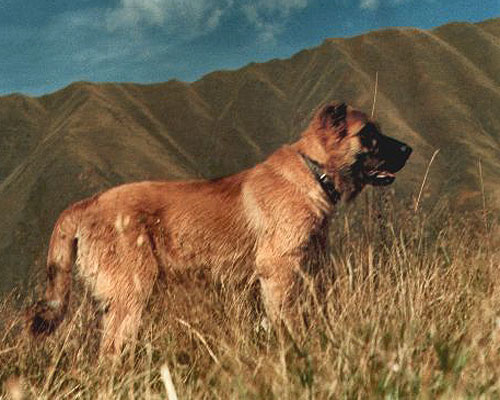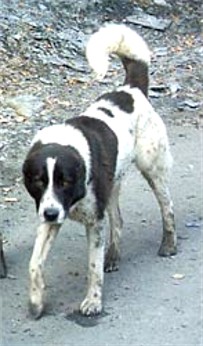Georgian Caucasian Sheepdog - Nagazi

 Considered to be the real Caucasian Ovcharka or at least its key progenitor by its fanciers, the Tushetian Nagazi is an ancient working breed from Georgia. Although the best representatives of the Caucasian Shepherd are said to come from Georgia, there is a difference between the Nagazi type and the Nagazi breed. This breed served as the foundation block for the establishment of the Russian Kavkaskaya Ovtcharka after the 2nd World War, but has remained both unchanged in its home region and unknown outside Georgia. The Tushetian Nagazi is related to the dogs of Armenia, Azerbaijan and Turkey, as well as to other types native to the Caucasian region, such as the Severno-Kavkaski Volkodav, but is believed to be a completely natural breed and an ancestor of many other Molossers. There are local varieties of the breed in Georgia, but the greatest value is placed on dogs from the Tusheti region. The Georgian Caucasian Sheepdog is now fully standardized and rightfully recognized as a separate breed in its native land, but generally ignored in Russia and other countries.
Considered to be the real Caucasian Ovcharka or at least its key progenitor by its fanciers, the Tushetian Nagazi is an ancient working breed from Georgia. Although the best representatives of the Caucasian Shepherd are said to come from Georgia, there is a difference between the Nagazi type and the Nagazi breed. This breed served as the foundation block for the establishment of the Russian Kavkaskaya Ovtcharka after the 2nd World War, but has remained both unchanged in its home region and unknown outside Georgia. The Tushetian Nagazi is related to the dogs of Armenia, Azerbaijan and Turkey, as well as to other types native to the Caucasian region, such as the Severno-Kavkaski Volkodav, but is believed to be a completely natural breed and an ancestor of many other Molossers. There are local varieties of the breed in Georgia, but the greatest value is placed on dogs from the Tusheti region. The Georgian Caucasian Sheepdog is now fully standardized and rightfully recognized as a separate breed in its native land, but generally ignored in Russia and other countries.

 A rugged and resilient worker, the breed was also employed as a fierce wardog in the past, although its main duties have traditionally been protecting livestock and guarding its master's property, but when compared to the Caucasian Ovcharka, the Nagazi isn't as visually appealing or impressive, due to its relatively small size and lighter physical built. However, this is a serious dog and an effective defender from predators, valued for its speed, agility and most of all, its great courage and intelligence. In some aspects, it is closer to the Sarplaninac and the North-Caucasian Volkodav than to the modern Russian and European Caucasian Ovcharkas, both in appearance and in temperament. The smaller size is explained by some as being a result of centuries of poor diet, but seing how Nagazis are well-loved and cared for by the Tushetian tribes and other villagers in Georgia, it is more likely that the breed developed naturally in accordance to its environment. Larger and heavier dogs simply wouldn't be as athletic and as superbly suited for the life in the harsh climates and terrains of the Georgian mountains as the pure Tushetian Nagazi is, but the size of the predators should also be taken into account, since bears and wolves in Georgia are quite smaller than those found in other regions of former Soviet Union.
A rugged and resilient worker, the breed was also employed as a fierce wardog in the past, although its main duties have traditionally been protecting livestock and guarding its master's property, but when compared to the Caucasian Ovcharka, the Nagazi isn't as visually appealing or impressive, due to its relatively small size and lighter physical built. However, this is a serious dog and an effective defender from predators, valued for its speed, agility and most of all, its great courage and intelligence. In some aspects, it is closer to the Sarplaninac and the North-Caucasian Volkodav than to the modern Russian and European Caucasian Ovcharkas, both in appearance and in temperament. The smaller size is explained by some as being a result of centuries of poor diet, but seing how Nagazis are well-loved and cared for by the Tushetian tribes and other villagers in Georgia, it is more likely that the breed developed naturally in accordance to its environment. Larger and heavier dogs simply wouldn't be as athletic and as superbly suited for the life in the harsh climates and terrains of the Georgian mountains as the pure Tushetian Nagazi is, but the size of the predators should also be taken into account, since bears and wolves in Georgia are quite smaller than those found in other regions of former Soviet Union.

 The Tushetian Nagazi is an intuitive and dominant dog, devoted to its master and aloof with strangers, although not vicious or unreliable. When raised with sheep from early puppyhood, the Nagazi bonds with the herd and will protect them with its life. Being a contestant in local fighting tournaments, it is fairly unfriendly towards strange dogs. However, the breed has been kept in fairly large working groups since ancient times, following the pack rules of hierarchy, but never questioning the master's authority. The Georgian Nagazi is a strong and lean dog, with a straight back, deep chest and muscular body. The head is comparatively smaller and narrower than that of the modern Caucasian Shepherd Dog and is more lupoid in features, while still being powerful and substantial. The ears are set high and have traditionally been cropped, whereas the tail can be seen both docked and in its natural state.
The Tushetian Nagazi is an intuitive and dominant dog, devoted to its master and aloof with strangers, although not vicious or unreliable. When raised with sheep from early puppyhood, the Nagazi bonds with the herd and will protect them with its life. Being a contestant in local fighting tournaments, it is fairly unfriendly towards strange dogs. However, the breed has been kept in fairly large working groups since ancient times, following the pack rules of hierarchy, but never questioning the master's authority. The Georgian Nagazi is a strong and lean dog, with a straight back, deep chest and muscular body. The head is comparatively smaller and narrower than that of the modern Caucasian Shepherd Dog and is more lupoid in features, while still being powerful and substantial. The ears are set high and have traditionally been cropped, whereas the tail can be seen both docked and in its natural state.
The coat is thick and hard, medium in length and densely undercoated. Shorthaired examples are also common, whereas dogs with overly long coats aren't preferred by the breed enthusiasts. The most valued colouring is uniform white, from pearl white to ivory shades, but many other colours can be encountered in the breed, such as fawn, brown, red, grey and various bicolours. Average height is around 24 inches, although slightly taller specimens exist as well.
